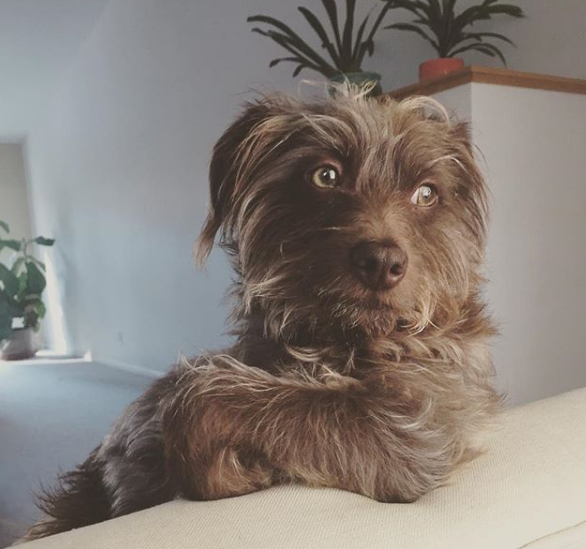Can You Be a Minimalist in a Large Space?
Image // Dwell. Design // Jessica Helgerson.
Hi friends, Cary here!
The question — can you live simply in a large home? — is something I've been mulling over since we moved into our first home two years ago.
Cam and I had lived, quite happily, in a one bedroom apartment in San Francisco for 6.5 years before our move to Boise. Our intention for purchasing a larger home was to have space to grow our own family –– babies both fur and human (see below) –– and for family and close friends to visit often and for as long as they’d like.
Truly, I love our home. I love our neighborhood: our kind and active neighbors, the dozens of miles of hiking trails right across the street and our fabulous public school down the block. I love our land: the fruit trees, the garden, the hillside and the bike path running past our backyard. But it was a really strange feeling going from an apartment with three closets (which felt down right luxurious at the time) to a home who seemed to invite us to have too much with a basement, a garage, a guest room, and nearly a dozen closets.
I'm not going to lie, I had a lot of anxiety about moving into a larger space.
I was worried that the clarity a smaller space enabled me to have would be lost and that I'd become the type of person who just fills up space in order to fill it. Backsliding into consumerism and mindlessly holding onto unwanted and unloved things seemed unavoidable.
And yet here we are, two years later, in a large and simple home.
How did this happen? By deciding before we moved, before we shopped, before we filled our space exactly how we wanted to feel in our home. It’s been our internal boundaries and clarity, rather than external forces, that have allowed us to create a home we love. Here are a few tips to keep in mind to help you stay the course of your version of minimalism.
5 Tips for Simple Living, No Matter the Size of Your House
My side of the closet in our S.F. apartment.
1. Don't add storage.
When you have plenty of closets and other built-in storage space, don't bring in additional dressers or cabinets, drawers or shelves. Allow the built in storage to be enough. We, for example, have the same coffee table that we used in SF (a glorious Japanese tansu that was handed down to me). In San Francisco we used the spacious drawers to hold board games and candles and things we used when entertaining friends. Here in Boise, we ignore the drawers all together. The drawers are not the easiest to open, nor is opening them conducive to the layout of the space. So we treat the tansu like a solid cube and enjoy it’s surfaces without utilizing it’s storage.
2) Remove storage where you don't need it.
For us, this looked like removing an entire wall of upper and lower cabinets from our garage. While the millions of drawers and shelves might have been “organized” and labeled to each hold one item – camping sporks in this drawer, headlamps and lanterns on this shelf - we didn’t want a complicated system and didn’t need nearly the amount of storage provided. Instead we have two large open shelving units that hold a bin with all our small camping gear on a shelf alongside our tents, camping chairs and sleeping bags. This makes packing and unpacking for car camping a breeze (Step 1: place bin in car; Step 2: camp; Step 3: remove bin from car and place back on shelf). This smaller, open storage also prevents us from hoarding unwanted and unneeded items out of sight.
Our old pantry in our S.F. apartment.
3) Redefine “full”.
We have a laundry room. Yes, a whole entire room dedicated to the act of laundry. It's a small space but it nonetheless has a couple of cabinets and drawers. One cabinet houses our large bag of dog food. Another holds the laundry detergent and white vinegar we use for cleaning. Thats it. Each cabinet could easily hold 10x what it has, but there isn't anything else that belongs in there, so we just let them be.
Adapting to a different version of "full." When we work with clients we are constantly helping them adjust their mindset to what “full” looks and feels like. For many of us, after years of overflowing drawers and cabinets that jussssst baaaarely close, it can feel strange to acknowledge that full is actually much less than capacity — it’s an amount that allows for ease and optimal functionality. In a large house we’ve taken this a step further even. “Full” in a linen closet might just be a spare pillow and seasonal throw or two. The idea is not to be austere, but to let my internal compass rather than my external storage tell me what is the right amount.
4) Go slowly.
When we moved we had neither the finances nor the desire to rush to fill-up our home with stuff. For example, in a bright extra bedroom that we hoped one day would become a nursery, we placed just one comfortable chair. A single chair was really all we needed to take work calls or sip coffee in this room’s morning sunlight. Now that it is a nursery I’m so glad we didn’t rush to furnish the room unnecessarily
The same goes for walls. We'd spent six years slowly decorating the three small rooms of our old San Francisco apartment. Here in Boise, I wanted to be just as thoughtful about adding decor rather than trying to rush around and appear “done” without getting to know the space and how we hope to feel in it. Two years in, we’re continuing to slowly add layers and textures and colors to our home as it feels right. I know some people won't be able to stand the feeling of being "incomplete" but I suggest moving forward with decorating as intentionally and mindfully as you can.
5) When in doubt, add plants and lighting.
For architectural or feng shui reasons, there are a couple of spaces in our home that feel awkward or unpleasant when empty. I cannot tell you how many times I thought about how if I'd built this house I would have removed a bizarre nook here or an extra few feet there. But instead of turning my back on these off-putting areas, we embraced them by slowly filling each with lovely greenery and lighting (luckily for me, Cam has quite the green thumb). Plants and light sources give purpose and interest to these spaces without adding the weight or expense of furnishings.
Decor doesn't have to be all furniture and artwork. If you don't need another place to sit, don't just stick a loveseat somewhere. Instead, use greenery and task lighting to make a space feel alive without filling it up for the sake of filling it.
Image // @urbanjungleblog





